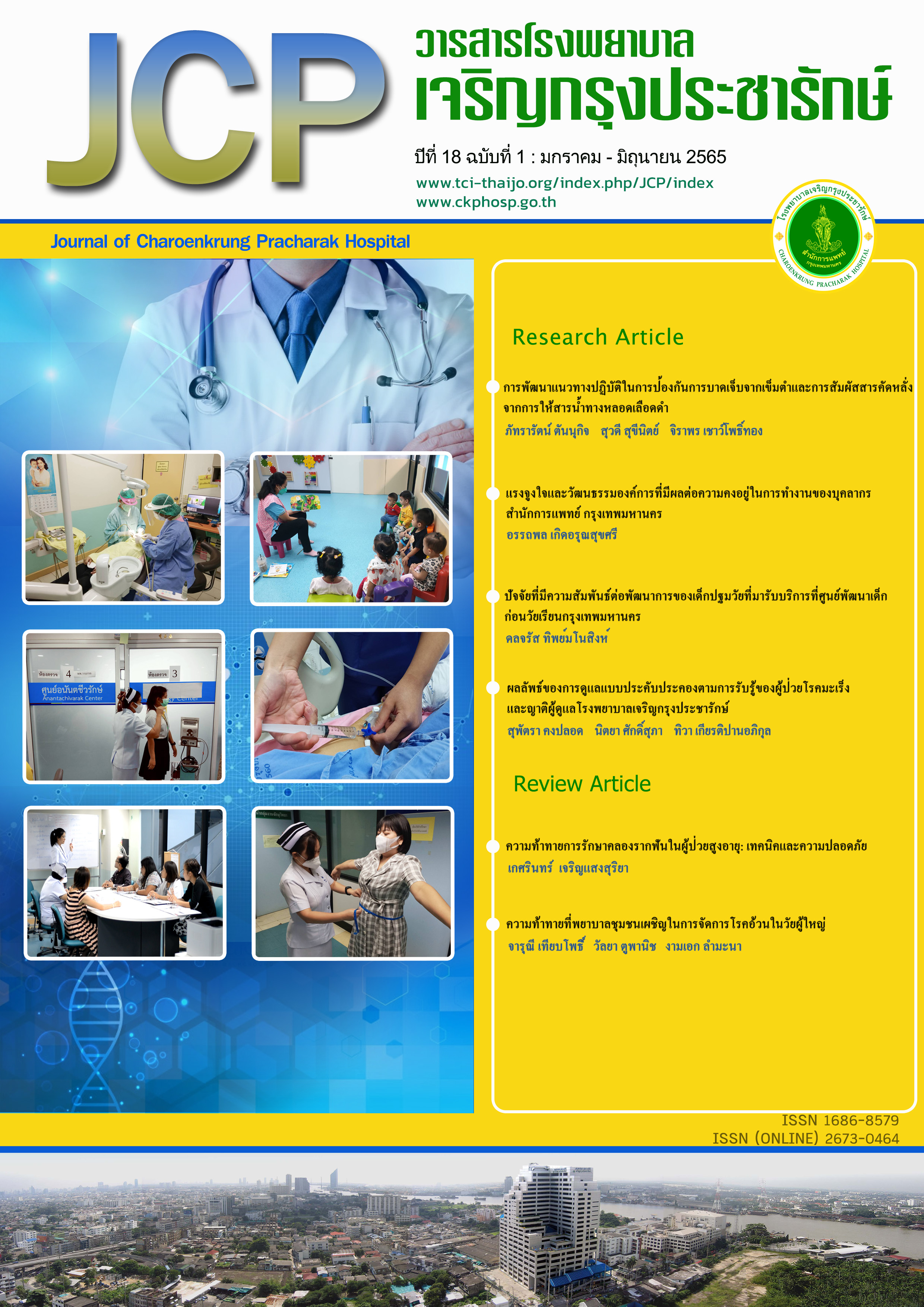ความท้าทายที่พยาบาลชุมชนเผชิญในการจัดการโรคอ้วนในวัยผู้ใหญ่
Main Article Content
บทคัดย่อ
บทนำ: โรคอ้วนเป็นปัญหาสาธารณสุขที่สำคัญพบได้ทั่วโลกรวมถึงประเทศไทยโรคอ้วนเป็นทั้งโรคไม่ติดต่อเรื้อรังและยังชักนำให้เกิดโรคไม่ติดต่อเรื้อรังสำคัญอื่นๆ เช่น โรคเบาหวาน โรคหลอดเลือดสมอง โรคหัวใจและหลอดเลือด โรคความดันโลหิตสูง และกลุ่มอาการเมตาบอลิก โรคอ้วนนับเป็นภัยเงียบใหม่เพราะโรคนี้ไม่ได้ทำให้เจ็บป่วยรุนแรงและเสียชีวิตอย่างกระทันหัน อัตราการเกิดโรคอ้วนในประเทศไทยได้เพิ่มขึ้นอย่างต่อเนื่อง โดยเฉพาะในวัยผู้ใหญ่จากร้อยละ 16.7 ในปี 2534เพิ่มเป็นร้อยละ 37.5ในปี 2557ปัจจุบันโรคอ้วนเป็นปัญหาสาธารณสุขของประเทศไทยในลำดับแรกๆที่ต้องได้รับการแก้ไขอย่างเร่งด่วนโดยเน้นการปรับเปลี่ยนวิถีชีวิตในการบริโภคอาหารและการออกกำลังกาย พยาบาลชุมชนควรมีความเข้าใจมากยิ่งขึ้นเกี่ยวกับความท้าทายในการผสานศาสตร์ต่าง ๆ นอกเหนือจากการพยาบาลในการจัดการโรคอ้วน
วัตถุประสงค์: เพื่อชี้ประเด็นที่เป็นความท้าทายในการจัดการโรคอ้วนในวัยผู้ใหญ่ในชุมชนโดยพยาบาลชุมชนเกี่ยวกับการประเมินภาวะโภชนาการ การปรับเปลี่ยนวิถีชีวิตในการบริโภคอาหารพลังงานต่ำการออกกำลังกายและการใช้เทคนิคการปรับเปลี่ยนพฤติกรรม
วิธีการดำเนินการศึกษา: การทบทวนวรรณกรรม
ผลการศึกษา: พยาบาลชุมชนมีบทบาทสำคัญมากในการป้องกันและควบคุมโรคอ้วน เพราะทำงานอย่างต่อเนื่องใกล้ชิดกับประชาชน และเข้าใจบริบทของชุมชน ทั้งเป็นผู้มีองค์ความรู้พื้นฐานด้านสุขภาพและการพยาบาลที่ดี ซึ่งจะสามารถชักนำและกระตุ้นประชาชนให้ปรับเปลี่ยนวิถีชีวิตของตนเองโดยเฉพาะประชาชนกลุ่มเสี่ยง แต่ความท้าทายที่พยาบาลชุมชนจะสามารถนำพาชุมชนให้ปลอดโรคอ้วนยังมีอยู่มาก อย่างน้อยที่สุดพยาบาลชุมชนต้องสามารถเป็นต้นแบบของการมีรูปร่างที่อยู่ในเกณฑ์ปกติหรือมีประสบการณ์การควบคุมน้ำหนักได้สำเร็จ นอกจากนั้นพยาบาลชุมชนที่เป็นต้นแบบควรได้รับการสนับสนุนให้มีความเข้าใจในการให้คำปรึกษาด้านโภชนาการและการออกกำลังกายรวมถึงเทคนิคในการปรับเปลี่ยนพฤติกรรมในการจัดการโรคอ้วนผสานเข้ากับศาสตร์ทางการพยาบาล เพื่อจะได้นำไปสร้างความสามารถให้กับบุคคลและชุมชนในการบริโภคอาหารพลังงานต่ำและการออกกำลังกายเป็นประจำให้เข้ากับบริบทที่เปลี่ยนแปลงอยู่เสมอ
สรุป: พยาบาลชุมชนควรได้รับการสนับสนุน แรงจูงใจ และการอบรมในการทำงานเชิงรุกที่ต้องผสานศาสตร์ต่างๆเข้าด้วยกัน ซึ่งจะทำให้แนวโน้มของการป้องกันโรคอ้วนมีทิศทางดีขึ้นในเวลาสั้น
Article Details

อนุญาตภายใต้เงื่อนไข Creative Commons Attribution-NonCommercial-NoDerivatives 4.0 International License.
เอกสารอ้างอิง
WHO. Overweight and obesity. [Internet]. 2020 [cited 2 Aug 2021] Available from: https://www.who.int/news-room/fact-sheets/detail/obesity-and-overweight
สถาบันวิจัยระบบสุขภาพ (2535) รายงานสำรวจสุขภาพสถานะของคนไทยด้วยการสอบถามและตรวจร่างกายทั่วประเทศ ครั้งที่ 1 พ.ศ. 2534-35. สืบค้น ส.ค. 2564 จาก https://www.hiso.or.th/hiso/picture/reportHealth/report/report5.pdf
วิชัย เอกพลากร. (บก.). (2557) รายงานการสำรวจสุขภาพประชาชนไทยโดยการตรวจร่างกาย ครั้งที่ 5 พ.ศ.2557. นนทบุรี: สถาบันวิจัยระบบสาธารณสุข.
Srivanichakorn S. Morbidity and mortality situation of non-communicable diseases (diabetes type 2 and cardiovascular diseases) in Thailand during 2010-2014. Disease and control journal 2017; 43:380-90.
Diabetes Prevention Program Research Group. Reduction in the incidence of type 2 diabetes with lifestyle intervention or metformin. N Engl J Med. 2002 February 7; 346(6): 393–403.
Thiabpho C, Changbumrung S, Soonthornworasiri N, Yoddumnern-Attig B, Thaboot P, Nissayan P, et al. Intensive lifestyle modification program on weight loss and metabolic syndrome risk reduction among obese women in rural areas of Thailand. Journal of Health Research. 2018;32(3):203-16.
Centers for disease control and prevention. Adult Obesity Facts. [Internet]. 2020 [cited 2021 Aug 10] Available from: https://www.cdc.gov/obesity/data/adult.html
Purnell JQ. Definitions, Classification, and Epidemiology of Obesity. 2018 Apr 12. In: Feingold KR, Anawalt B, Boyce A, Chrousos G, de Herder WW, Dhatariya K, et al., editors. Endotext [Internet]. South Dartmouth (MA): MDText.com, Inc.; 2000–. PMID: 25905390. [Internet]. 2020.[cited 2021 Aug 16] Available from: https://www.ncbi.nlm.nih.gov/books/NBK279167/
Lavie CJ, Laddu D, Arena L, Ortega FD, Alpert MA, Robert F, et al. Healthy weight and obesity prevention: JACC health promotion series. J Am Coll Cardiol. 2018;72(13):1506-31.
Mohammad S, Aziz R, Al Mahri S, Malik SS, Haji E, Khan AH, et al. Obesity and COVID-19: what makes obese host so vulnerable? Immun Ageing. 2021;18(1):1.
Center disease control. National health and nutrition examination survey (NHNES): Anthropometry procedure manual. [Internet]. 2020 [cited 2021 Aug 16] Available from: https://wwwn.cdc.gov/nchs/data/nhanes/2019-2020/manuals/2020-Anthropometry-Procedures-Manual-508.pdf
WHO. Global database on BMI. [Internet]. 2007 July [Cited 2020 Aug 1] Available from: http://www.assessmentpsychology.com/icbmi.htm
WHO expert consultation. Appropriate body-mass index for Asian populations and its implications for policy and intervention strategies. Lancet. 2004 Jan 10;363(9403):157-63.
Ma WY, Yang CY, Shih SR, Hsieh HJ, Hung CS, Chiu FC, et al. Measurement of Waist Circumference: midabdominal or iliac crest? Diabetes Care. 2013;36(6):1660-6.
Moy MF, Bulgiba A. The modified NCEP ATP III criteria maybe better than the IDF criteria in diagnosing Metabolic Syndrome among Malays in Kuala Lumpur. BMC Public Health 2010, 10:678. http://www.biomedcentral.com/1471-2458/10/678z.
Herath HMM, Weerasinghe NP, Weerarathna TP, Amarathunga A. A Comparison of the Prevalence of the Metabolic Syndrome among Sri Lankan Patients with Type 2 Diabetes Mellitus Using WHO, NCEP-ATP III, and IDF Definitions. Int J Chronic Dis. 2018;2018:7813537.
Alberti KG, Eckel RH, Grundy SM, Zimmet PZ, Cleeman JI, Donato KA, et al. Harmonizing the metabolic syndrome: a joint interim statement of the International Diabetes Federation Task Force on Epidemiology and Prevention; National Heart, Lung, and Blood Institute; American Heart Association; World Heart Federation; International Atherosclerosis Society; and International Association for the Study of Obesity. Circulation. 2009;120(16):1640-5.
Semlitsch T, Stigler FL, Jeitler K, Horvath K, Siebenhofer A. Management of overweight and obesity in primary care-A systematic overview of international evidence-based guidelines. Obes Rev. 2019;20(9):1218-30.
Miltenberger RG. Behavior modification principle and procedures. 4th ed. Australia: Thomson Wadsworth; 2008
Knowler WC, Barrett-Connor E, Fowler SE, et al; Diabetes Prevention Program Research Group. Reduction in the incidence of type 2 diabetes with lifestyle intervention or metformin. N Engl J Med. 2002;346(6):393-403.
Knowler WC, Fowler SE, Hamman RF, et al; Diabetes Prevention Program Research Group. 10-year follow-up of diabetes incidence and weight loss in the Diabetes Prevention Program Outcomes Study. Lancet. 2009;374(9702):1677-1686.
Hamman RF, Wing RR, Edelstein SL, et al. Effect of weight loss with lifestyle intervention on risk of diabetes. Diabetes Care. 2006;29(9):2102-2107.
Katz DL. Nutrition in clinical practice. 4th ed. Philadelphia: Lippincott William and Wilkins; 2015.
Wadden TA, Tronieri JS, Butryn ML. Lifestyle modification approaches for the treatment of obesity in adults. Am Psychol. 2020;75(2):235-51.
U.S Department of health and human services, National Institutes of health, National heart, lung, and blood institute. Managing overweight and obesity in adults: systemic evidence from the obesity expert panel, [Internet].2013.[cited 2021 Aug 8] Available from: http://www.nhibi.nih.gov/guidelines
Nieman DC. Nutritional assessment. 7th ed. New York: McGraw-Hill Education, 2019.
รุจิรา สัมมะสุต. 2547. รายการอาหารแลกเปลี่ยนไทย (Thai food exchange list). วารสารโภชนบําบัด, 15(1): 33-45.
World Health Organization. WHO guidelines on physical activity and sedentary behaviour. World Health Organization. [Internet]. 2020 [cited 2021 Aug 9] Available from: https://apps.who.int/iris/handle/10665/336656.
Donnelly JE, Blair SN, Jakicic JM, Manore MM, Rankin JW, Smith BK, et al. American College of Sports Medicine Position Stand. Appropriate physical activity intervention strategies for weight loss and prevention of weight regain for adults. Med Sci Sports Exerc. 2009;41(2):459-71.
Kim BY, Choi DH, Jung CH, Kang SK, Mok JO, Kim CH. Obesity and Physical Activity. J Obes Metab Syndr. 2017;26(1):15-22.


